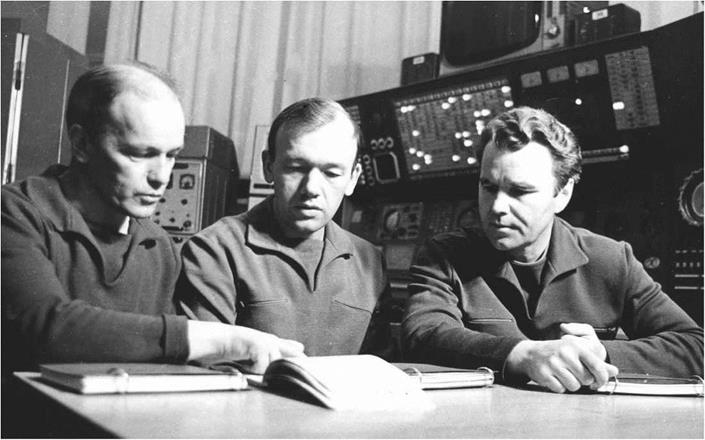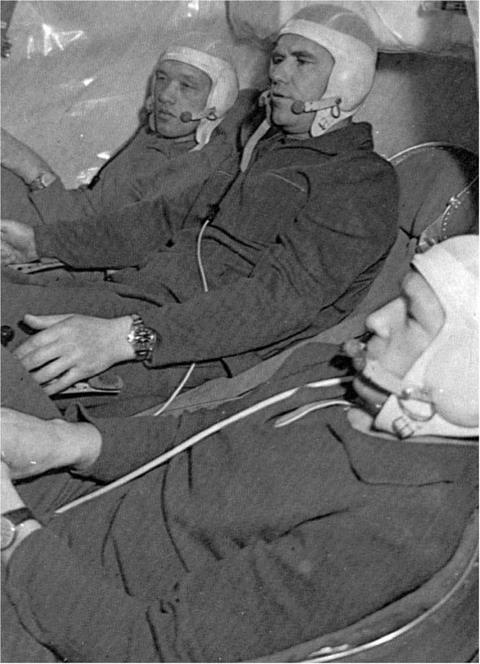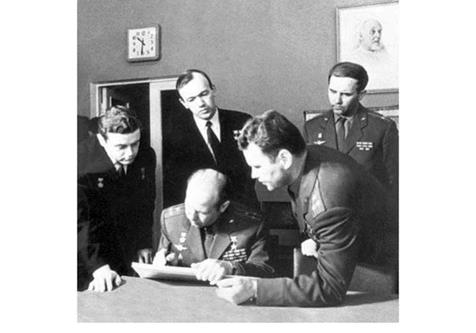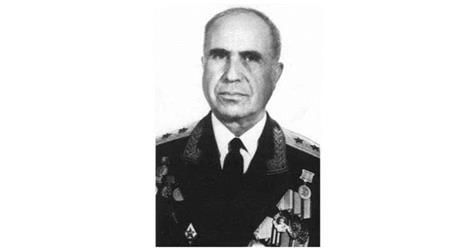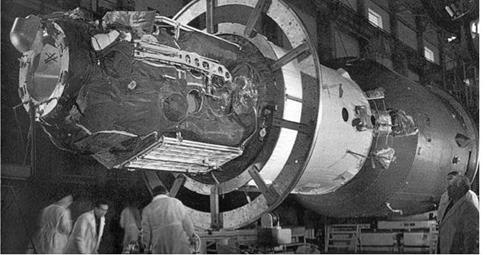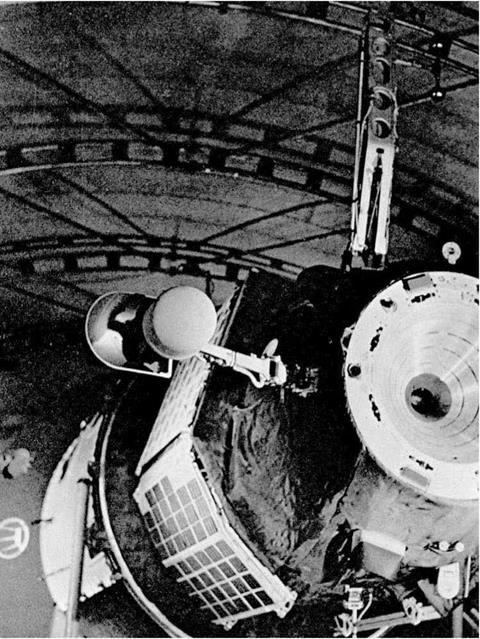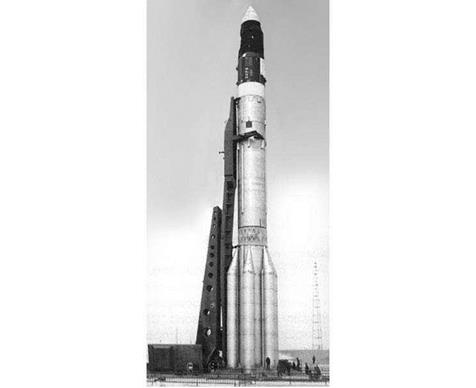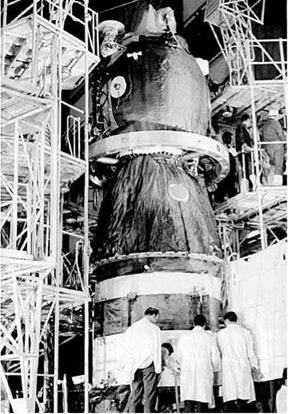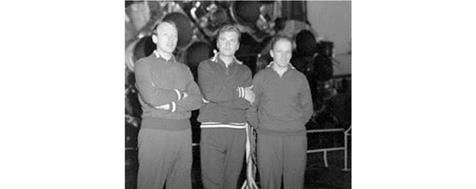SPACE STATION LAUNCH
Meanwhile, the crews were wrapping up their training programmes in Zvyozdniy and Kaliningrad. On 9 March Shatalov, Yeliseyev and Rukavishnikov spent more than 14 hours in the Soyuz simulator, rehearsing each major phase of the mission – launch, rendezvous and docking, undocking, re-entry and landing – in the process overcoming five simulated anomalies, including the failure of the main engine and an excessive rate of fuel consumption. Leonov’s crew had a similar session the next day, and Dobrovolskiy’s crew three days later. This completed the formal training. On 16 March they had their final exams, and achieved the best possible score. Three days later, the State Commission confirmed that an attempt would be made to launch the station in the period 15-18 April, but left undecided the duration of the first crew’s mission.
Did anyone in the West have a suspicion of the imminence of such an important event in cosmonautics? Of course, Brezhnyev’s speech and the newspaper articles by Academicians Keldysh and Petrov had said that the Soviet Union was interested in a space station. Some of this was reported overseas. For example, on 16 March 1971 the Guardian in London published an article entitled ‘Russia Plans the First Station in Space’. And in an interview with the newspaper Socialist Industry, an unidentified Chief Designer (Mishin?) predicted: ‘‘It seems to me expedient to build in the near future a station in space near the Earth that would operate for a long time. The flight of Soyuz 9, which lasted 18 days, was an important step in this direction. A time will come when manned Soviet research laboratories will orbit the Earth.’’ Western newspapers speculated that the next long-duration manned mission might coincide with the 24th Congress of the Soviet Communist Party, which was to open on 30 March.
On 20 March the three crews travelled to Baykonur on separate Tu-104 aircraft, and on arrival went to the so-called ‘Cosmonaut Hotel’. Over the next three days they performed final rehearsals on board the Soyuz 10 spacecraft in the Assembly – Test Building (MIK) near Pad No. 1; the pad from which first Sputnik and later Gagarin had lifted off. The rocket was being checked elsewhere in the building. Chelomey’s preparation facility was near Pad No. 82, from which his Protons were launched. The DOS-1 station and its launcher were being checked out in one building while construction was underway nearby of the building in which the spacecraft for the Almaz programme would be prepared.
The cosmonauts flew back to Moscow in order to attend the meeting of the VPK Military-Industrial Commission on 25 March. Mishin said that it should be possible to launch the station in the period 15-20 April, with Soyuz 10 lifting off 3 days later. He recommended that Shatalov, Yeliseyev and Rukavishnikov’s mission should last a month, and that 25 days later Leonov, Kubasov and Kolodin should set off for a mission of up to 45 days. It was decided to assign the first crew a 30-day mission, but to postpone making a decision on the length of the second mission until the state of health of the first crew had been assessed upon their return. However, looking on the optimistic side, the second crew were to train on the presumption that they were to conduct a 45-day mission.
|
|
|
Yeliseyev (rear), Shatalov and Rukavishnikov in the Soyuz simulator. |
 |
As ‘known’ cosmonauts, Shatalov and Yeliseyev were directed to attend the 24th Congress of the Soviet Communist Party. Less than a month before the launch of the first space station, two members of the prime crew spent 6 days as delegates at a political meeting! In accordance with tradition, the cosmonauts visited Red Square and Gagarin’s office in Zvyozdniy. Then there was a final meeting with Mishin, Bushuyev, Chertok and Semyonov at the TsKBEM, which was attended by Nikolay Lobanov, who was the Chief Designer of the Scientific-Research and Experimental Institute of the Parachute Landing Service, and Gay Severin, the General Designer of OKB Zvezda which supplied the spacecraft crew couches and the suits and other apparatus required to undertake spacewalks.
On 6 April the three crews returned to Baykonur. They conducted a final round of training on board the space station and the Soyuz 10 spacecraft, and then these were mated with their launchers. On 9 April the State Commission decided to install the Proton on the pad at 7.00 a. m. local time on 15 April, with a view to launching it at 6.40 a. m. (4.40 a. m. Moscow Time) on 19 April. General Kerimov, who chaired the meeting, expressed the Kremlin’s dissatisfaction with the name ‘Zarya’. It appeared that China was developing a rocket with this name. The Kremlin wanted the station to be renamed. In fact, there was another reason to change the name, as ‘Zarya’ was the radio call-sign of the mission control centre in communications with a manned spacecraft. Kerimov suggested that the name on the side of the vehicle be repainted. Chertok objected, pointing out that as the Americans would surely not be able to photograph the station in orbit it was unnecessary to repaint the vehicle! After much discussion, someone proposed Salyut (‘Салют’; meaning ‘Salutation’ or ‘Greeting’)
|
|
It is traditional for cosmonauts to visit Gagarin’s office at the TsPK in Zvyozdniy prior to departing for Baykonur. Here Volkov (left), Yeliseyev, Dobrovolskiy and Shatalov (foreground) look on as Leonov writes in the visitors’ book. A picture of Konstantin Tsiolkovskiy hangs on the wall.
and this was unanimously accepted. As there was no time to repaint the name, the station was mated with the third stage of the Proton bearing the name ‘Zarya’ on its side.[29]
The final meeting of the State Commission prior to the launch of DOS-1 was held on 18 April. After representatives of the TsKBEM and the TsKBM reported on the status of the Proton and its payload, the preparations for Soyuz 10 were reviewed.
At 4.39 a. m. Moscow Time on Monday, 19 April 1971, Salyut (DOS-7K No. 1) was successfully launched as the world’s first space station – it was only 16 months since the decision was taken to initiate the programme!
The initial parameters of the station’s orbit were 200 x 222 km at an inclination of 51.6 degrees to the equator, with a period of 88.5 minutes. Although the launch had been flawless, the radio-telemetry during the first revolution showed a problem: the cover that had protected the aperture of the main scientific module during the ascent through the atmosphere had failed to jettison. As this module held 90 per cent of the observational apparatus, the station’s scientific results would be severely curtailed if the cover could not be released.
|
|
Right: Three weeks prior to their launch, Yeliseyev and Shatalov attend the 24th Congress of the Soviet Communist Party. Left: Afterwards, in Red Square, with Rukavishnikov.
|
|
The Soyuz 10 cosmonauts with the mission’s technical managers: Semyonov (left), Bushuyev, Yeliseyev, Chertok, Mishin, Lobanov, Shatalov, Severin and Rukavishni – kov.
|
Since 1966, General Kerim Kerimov from the Strategic Rocket Forces was the chairman of the State Commission for Soyuz missions. |
Although the Soviet news outlets featured the launch, other than describing Salyut as “an orbital scientific station” their reports revealed little of its nature and mission. However, the fact that it bore a name at all implied that it was a substantially new type of spacecraft, and the report that three ships had been stationed in the Atlantic to communicate with it was a clue that it might be associated with the manned space programme.[30] TASS said the flight was going as planned, and that an adjustment to its orbit had been made. The routine phrase “functioning normally” was applied to the performance of its systems. The bland statement of its purpose as being “to perfect the elements of the design and on board systems, and to conduct scientific research and experiments in space” simply meant wait and see.
Meanwhile, at Baykonur the final preparations were initiated to launch Soyuz 10. To preclude injuries at this late stage, the crew were prohibited from participating in sporting activities such as basketball, handball, volleyball, tennis and soccer – all of which were popular among the cosmonauts. However, they were allowed to run 10 kilometres per day to maintain their fitness. Anyone coming into close contact with them wore a protective face mask to minimise the risk of passing on any respiratory infections that might jeopardise the planned duration of the mission.
Early on the morning of 20 April the rocket bearing Soyuz 10 was installed on Pad No. 1. Several hours later, the State Commission presented the cosmonauts to space journalists. The prime crew was Colonel Vladimir Shatalov (44), commander; Aleksey Yeliseyev (37), flight engineer; and Nikolay Rukavishnikov (39), research engineer. The backup crew was Colonel Aleksey Leonov (37), commander;
|
|
The DOS-1 station in the Assembly-Test Building at Baykonur. On the left is the transfer compartment, with the smaller (white cylinder in the middle) and larger working compartments (right). On the transfer compartment can be seen two folded solar panels, a rendezvous antenna, and the docking port (far left).
|
|
A view of the DOS-1 station in the Assembly-Test Building in which the vehicle has been partially rotated. The ‘hole’ on the right of the main compartment is the aperture to enable the main scientific equipment to see out. It was sealed by a protective cover for launch.
|
|
Final testing of the DOS-1 station prior to mating with the Proton launch vehicle. The rendezvous antennas are deployed upward and to the left of the passive docking system. The central hole of the docking cone is to capture the head of the probe on the Soyuz. The TsKBEM’s logo is visible on the short conical adapted between the small and large working compartments (far left).
|
|
A Proton launch vehicle with the DOS-1 station on the pad at Baykonur. The wide part of the working compartment is exposed, but the narrower part and the transfer compartment are inside a shroud for the ascent through the atmosphere. The white support ring below is jettisoned after orbital insertion. The original name ‘Zarya’ is visible on the working compartment. Also visible is the white protective cover for the scientific equipment aperture.
Valeriy Kubasov (36), flight engineer; and Lieutenant-Colonel Pyotr Kolodin (41), research engineer.[31] And, of course, there was the support crew: Lieutenant-Colonel Georgiy Dobrovolskiy (43), commander; Vladislav Volkov (36), flight engineer; and Viktor Patsayev (38), research engineer.
Let us take a closer look at each member of the prime crew.
|
|
Engineers test systems in the propulsion module of the Soyuz 10 spacecraft in the Assembly-Test Building at Baykonur.
|
|
Yeliseyev, Shatalov and Rukavishnikov (right) in the Assembly-Testing Building at Baykonur. In the background is the engine cluster of the Soyuz launch vehicle.











